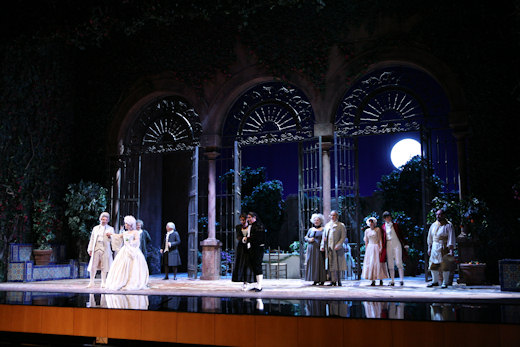Other Links
Editorial Board
- UK Editors
- Roger Jones and John Quinn
Editors for The Americas - Bruce Hodges and Jonathan Spencer Jones
European Editors - Bettina Mara and Jens F Laurson
Consulting Editor - Bill Kenny
Assistant Webmaster -Stan Metzger
Founder - Len Mullenger
Google Site Search
SEEN AND HEARD INTERNATIONAL OPERA REVIEW
Mozart, Le Nozze di Figaro:
Soloists, Orquesta Sinfónica de Navarra. Orfeón Pamplonés. Conductor: Ernest Martínez Izquierdo. Auditorio El Baluarte de Pamplona. 25.11.2010. (JMI)
Production Teatro Real de Madrid in coproduction with Las Palmas’s Teatro Pérez Galdós and Bilbao’s ABAO.
Direction: Emilio Sagi (Original).
Nuria Castejón (Revival).
Sets: Daniel Bianco.
Costumes: Renata Schussheim.
Lighting: Eduardo Bravo (Original)
José Luis Canales (Revival).
Cast:
Figaro: Iñaki Fresán.
Susanna: Sabina Puértolas.
Countess: Maria Bayo.
Count: David Menéndez.
Cherubino: Sophie Marilley.
Marcellina: Francisca Beaumont.
Don Bartolo: Alfonso Echavarría.
Basilio: Jon Plazaola.
Barbarina: Amaia Azcona.
Antonio: Pablo Azpeitia.
Don Curzio: Iker Bengotxea.
Emilio Sagi’s production premiered at Madrid Teatro Real in July last year, and was also reviewed in performances in Bilbao last April. Here is what I wrote about Sagi’s work then
(See
Review.)

Production Picture Courtesy of
Auditorio El Baluarte de Pamplona
It is never easy to conduct
The cast contained three local singers, which might have been useful in terms of box office attraction but was more debatable on artistic grounds. Figaro was Iñaki Fresán, who was totally miscast. Singing this role needs a lot more than just delivering notes competently. It needs emotional expression that and to give some meaning to the words and sadly here there was almost nothing of the kind. It is hard to imagine a less lively Figaro and there were problems with audibility at the lower ends of the tessitura. Fortunately, Sabina Puértolas was fun as intensely lively Susanna, who was fully convincing in almost every respect.. My only slight quibble is that I find her soprano slightly too light for Susanna.
Maria Bayo was the third local singer in this opera. She was a Countess with a voice that is still more suited to Susanna. While I can understand that Ms Bayo does not see herself as Susanna now, it is not simply age that makes any soprano the Countess, but the voice. She had a worrying start in "Porgi Amor", improving later to singing "Dove sono" with great taste. Sadly, the wonderful duet that Mozart wrote for the two sopranos was not well served by two light voices, since we lost the necessary contrast between their voices.
David Menéndez gave real life to Count Almaviva at least gave meaning and intention to what he was singing. His voice has never been particularly beautiful however and still is not even though he can be a very persuasive singer in the right roles. Here he managed most things very well except for his third act aria, "Hai gia vinta la causa" where he had some problems towards the end.
Sophie Marilley was a modest and adequate Cherubino whose two arias never really put much heat into the audience. Her voice is not large, but she did bring some fine musicality in the role.
There were also problems now and then with the secondary characters. I liked Jon Plazaola as Basilio and Amaia Azcona in Barbarina. By contrast, Francisca Beaumont had only limited appeal as Marcellina, while Alfonso Echevarria was a very modest Don Bartolo. Pablo Azpeitia’s Antonio was unfortunately sometimes inaudible.
The Baluarte was full for the performance but the audience did
not seem over enthusiastic during much of the performance. At the end though, all the artists were warmly received for their final bows, with the greatest applause saved for Sabina Puértolas’s Susanna.
José M Irurzun
